Filter by
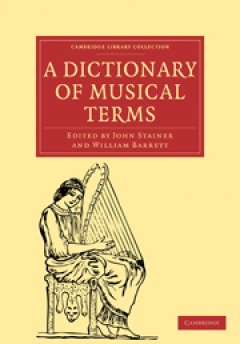
A Dictionary of Musical Terms
This illustrated dictionary, written by the prolific Victorian composer Sir John Stainer (1840–1901) – best remembered today for his oratorio The Crucifixion – and W. A. Barrett, was first published by Novello in 1876. It provides definitions for 'the chief musical terms met with in scientific, theoretical, and practical treatises, and in the more common annotated programmes and newspaper…
- Edition
- -
- ISBN/ISSN
- 9780511693007
- Collation
- -
- Series Title
- Cambridge Library Collection - Music
- Call Number
- -

A Dictionary of Music and Musicians (A.D. 1450–1880)
This is a reissue of the first edition of George Grove's Dictionary of Music and Musicians, which has since evolved to become the largest and most authoritative work of its kind in English. The project grew in the making: the title page of Volume 1 (1879) refers to 'two volumes', but by the time Volume 4 appeared in 1889 there was also a 300-page appendix and a separate index volume. The dictio…
- Edition
- -
- ISBN/ISSN
- 9780511703300
- Collation
- -
- Series Title
- Cambridge Library Collection - Music
- Call Number
- -

A Dictionary of Music and Musicians (A.D. 1450–1880)
This is a reissue of the first edition of George Grove's Dictionary of Music and Musicians, which has since evolved to become the largest and most authoritative work of its kind in English. The project grew in the making: the title page of Volume 1 (1879) refers to 'two volumes', but by the time Volume 4 appeared in 1889 there was also a 300-page appendix and a separate index volume. The dictio…
- Edition
- -
- ISBN/ISSN
- 9780511703324
- Collation
- -
- Series Title
- Cambridge Library Collection - Music
- Call Number
- -
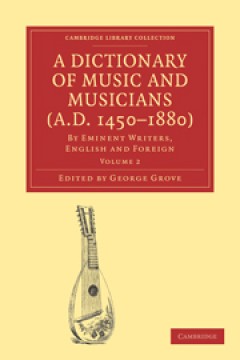
A Dictionary of Music and Musicians (A.D. 1450–1880)
This is a reissue of the first edition of George Grove's Dictionary of Music and Musicians, which has since evolved to become the largest and most authoritative work of its kind in English. The project grew in the making: the title page of Volume 1 (1879) refers to 'two volumes', but by the time Volume 4 appeared in 1889 there was also a 300-page appendix and a separate index volume. The dictio…
- Edition
- -
- ISBN/ISSN
- 9780511703317
- Collation
- -
- Series Title
- Cambridge Library Collection - Music
- Call Number
- -
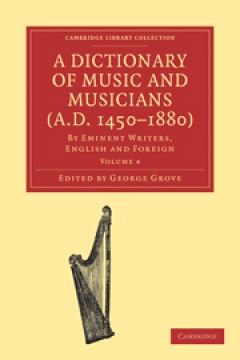
A Dictionary of Music and Musicians (A.D. 1450–1880)
This is a reissue of the first edition of George Grove's Dictionary of Music and Musicians, which has since evolved to become the largest and most authoritative work of its kind in English. The project grew in the making: the title page of Volume 1 (1879) refers to 'two volumes', but by the time Volume 4 appeared in 1889 there was also a 300-page appendix and a separate index volume. The dictio…
- Edition
- -
- ISBN/ISSN
- 9780511703331
- Collation
- -
- Series Title
- Cambridge Library Collection - Music
- Call Number
- -

“Why Aren't They Talking?” The Sung-Through Musical from the 1980s to the…
In the American musical theater, the most typical form of structuring musicals has been the book musical, in which songs interrupt spoken dialogue and add means to depict characters and dramatic situations. After 1980, a form of structuring musicals that expands upon the aesthetic conventions of the book musical came to prominence. Sung-through musicals challenged the balance between talking an…
- Edition
- -
- ISBN/ISSN
- 9781108866866
- Collation
- -
- Series Title
- -
- Call Number
- -

Carmen Abroad: Bizet's Opera on the Global Stage
From the 'old world' to the 'new' and back again, this transnational history of the performance and reception of Bizet's Carmen – whose subject has become a modern myth and its heroine a symbol – provides new understanding of the opera's enduring yet ever-evolving and resituated presence and popularity. This book examines three stages of cultural transfer: the opera's establishment in the r…
- Edition
- -
- ISBN/ISSN
- -
- Collation
- -
- Series Title
- -
- Call Number
- -
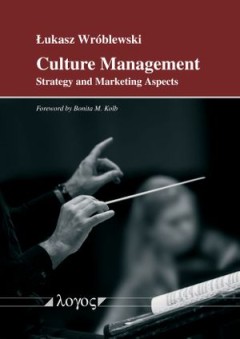
Culture Management : Strategy and marketing aspects
"Dr Lukasz Wroblewski's book Culture Management: Strategy and Marketing Aspects clearly recognises that the pressures on the cultural sector in the 21st Century are greater than ever before. Based on robust academic research within a practical industry context, this book addresses all the key issues related to marketing strategy and planning for the cultural industries. It will be an invaluable…
- Edition
- -
- ISBN/ISSN
- 9783832543785
- Collation
- -
- Series Title
- -
- Call Number
- 745 CUL
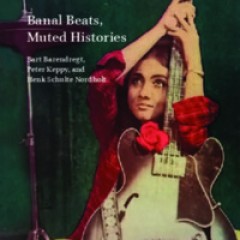
Popular Music in Southeast Asia : Banal Beats, Muted Histories
From the 1920s on, popular music in Southeast Asia was a mass-audience phenomenon that drew new connections between indigenous musical styles and contemporary genres from elsewhere to create new, hybrid forms. This book presents a cultural history of modern Southeast Asia from the vantage point of popular music, considering not just singers and musicians but their fans as well, showing how the …
- Edition
- -
- ISBN/ISSN
- 9789048534555
- Collation
- -
- Series Title
- -
- Call Number
- 780 BAR p
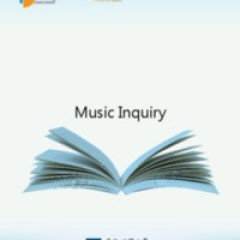
Music Inquiry
An inquiry based approach to learning about music provides flexible lessons that deepen and broaden learners' understanding of music while engaging with their current musical interests, preferences, and goals. This hands-on experience with inquiry in a subject area that appeals to most learners also provides practice in selfdirected learning that can be applied in any area of life-long learning.
- Edition
- -
- ISBN/ISSN
- -
- Collation
- -
- Series Title
- -
- Call Number
- 780 SCH m
 Computer Science, Information & General Works
Computer Science, Information & General Works  Philosophy & Psychology
Philosophy & Psychology  Religion
Religion  Social Sciences
Social Sciences  Language
Language  Pure Science
Pure Science  Applied Sciences
Applied Sciences  Art & Recreation
Art & Recreation  Literature
Literature  History & Geography
History & Geography